Relapsed or Refractory Diffuse Large B-Cell Lymphoma: “Dazed and Confused”
This review article written by Meghana Kesireddy, MBBS and Matthew A. Lunning, MD, reviews management and treatment of relapsed/refractory large B-cell lymphoma.
ABSTRACT
Diffuse large B-cell lymphoma (DLBCL) is the most common type of non-Hodgkin lymphoma. Approximately 30% to 40% of patients will develop relapsed/refractory (R/R) DLBCL, leading to significant morbidity and mortality. Salvage chemoimmunotherapy followed by high-dose chemotherapy and autologous stem cell rescue (HDT-ASCR) is the standard of care for chemosensitive and transplant-eligible R/R DLBCL. In patients who are ineligible for HDT-ASCR or who fail HDT-ASCR, treatment is mostly with palliative intent. However, the recent advances with chimeric antigen receptor T-cell (CAR-T) therapy and several FDA-approved targeted agents are changing the current landscape of R/R DLBCL management. There is no one-size-fits-all approach, and guidance regarding optimal sequencing of subsequent therapies is an unmet need. This review highlights the approved CAR-T constructs, including their efficacy, adverse effects, and real-world data; bridging therapy to CAR-T; the role of emerging targeted agents, including bispecific antibodies; and the timing of these targeted agents in relation to CAR-T therapy. Providing individualized treatment with thoughtful sequencing of available agents is essential until future prospective randomized clinical trials provide more insights.
Oncology (Williston Park). 2022;36(6):366-375.
DOI: 10.46883/2022.25920963
Introduction
Diffuse large B-cell lymphoma (DLBCL) is the most common subtype of non-Hodgkin lymphoma (NHL) and accounts for 30% to 40% of all NHL cases. The median age at diagnosis is 64 years, with 50% to 60% of patients with DLBCL achieving and maintaining complete remission (CR) after first-line therapy. Approximately 10% to 15% of patients will experience primary progressive or refractory disease, and 30% to 40% will relapse during the first 2 years.1 Relapses are usually diagnosed due to the development of new symptoms and rarely from surveillance imaging.2
In relapsed/refractory (R/R) DLBCL, repeat biopsy should be considered to confirm the NHL subtype, and eligibility determination for high-dose therapy and autologous stem cell rescue (HDT-ASCR) is of immediate importance. If a patient is eligible for HDT-ASCR, the second-line age-adjusted International Prognostic Index (IPI) score can predict the prognosis.3,4 The response to salvage chemoimmunotherapy regimens is lower in primary refractory disease and early relapse, and this lower response is usually associated with poor prognosis. In SCHOLAR-1, a large multitrial retrospective analysis, patients with primary refractory disease had a CR rate of only 3% with a median survival of only 7 months.5 In the ORCHARD trial (NCT01014208), patients with late relapse (relapse >12 months from completion of treatment) had a better overall response rate (ORR; 67% vs 29%), better progression-free survival (PFS; HR, 0.32; P<.0001), and better overall survival (OS; HR, 0.4; P<.001) compared with patients with primary refractory/early relapse.6 In the rituximab (Rituxan) era, only a minority of patients will have a second-line response amenable to proceed to consolidative HDT-ASCR.6 The tiers of the DLBCL treatment algorithm were previously static. Recently, however, numerous single-arm studies have led to a flurry of FDA approvals. As a result of these overlapping approvals, a clinician can become “dazed and confused” in managing R/R DLBCL. The R/R DLBCL algorithm anticipated to be used in the immediate future is depicted in the Figure.
FIGURE. Relapsed/Refractory Treatment Algorithm
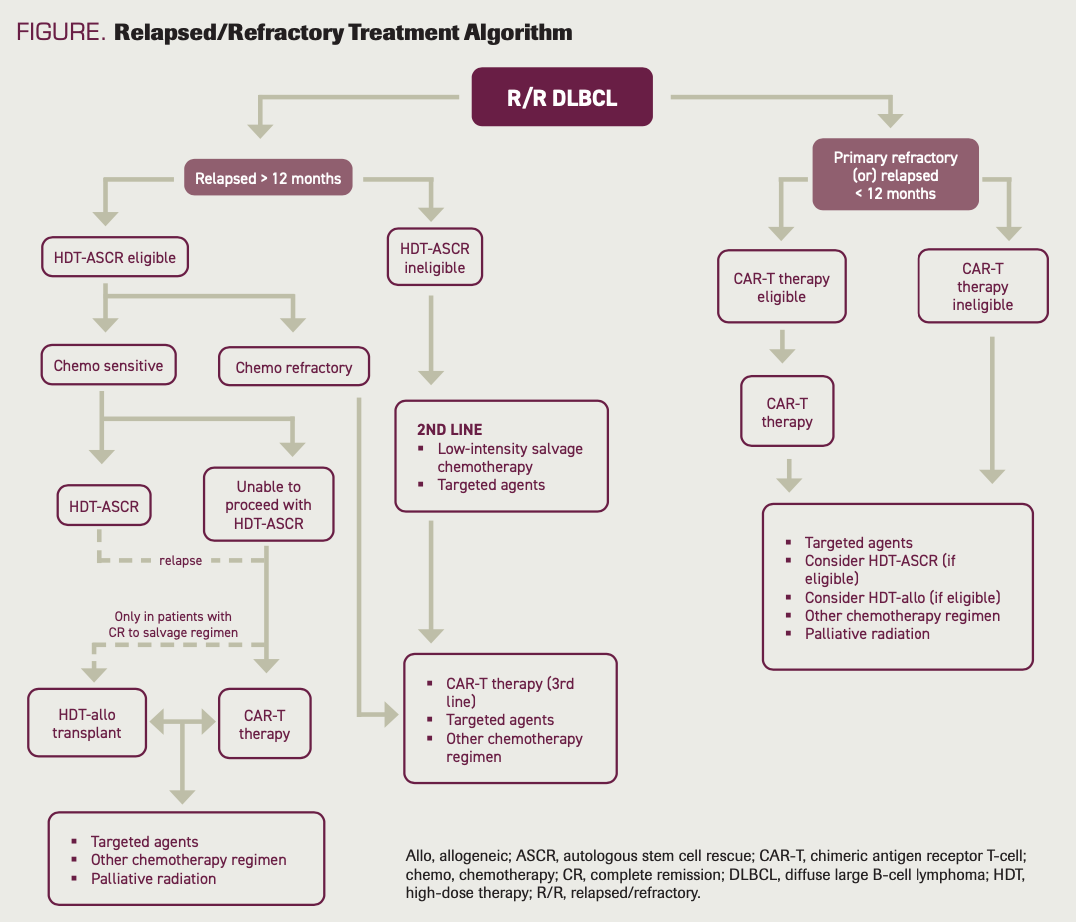
“Dazed” by the Data
Chimeric antigen receptor T-cell (CAR-T) therapy is now a fixture in the treatment algorithm for patients who have received 2 or more prior lines of therapy for DLBCL. Currently, 3 CAR-T constructs are approved for R/R DLBCL: axicabtagene ciloleucel (axi-cel; Yescarta), tisagenlecleucel (tisa-cel; Kymriah), and lisocabtagene maraleucel (liso-cel; Breyanzi). All approved CAR-T constructs target CD19, with multiple products in clinical trials and are beyond the scope of this review.
Each CAR-T therapy was approved based on single-agent activity in the defined population of the respective registrational trial (Tables 1 and 2).
TABLE 1. Patient Characteristics and Efficacy Outcomes of Phase 2 Trials Leading to Approval of CAR-T Therapy for R/R DLBCL
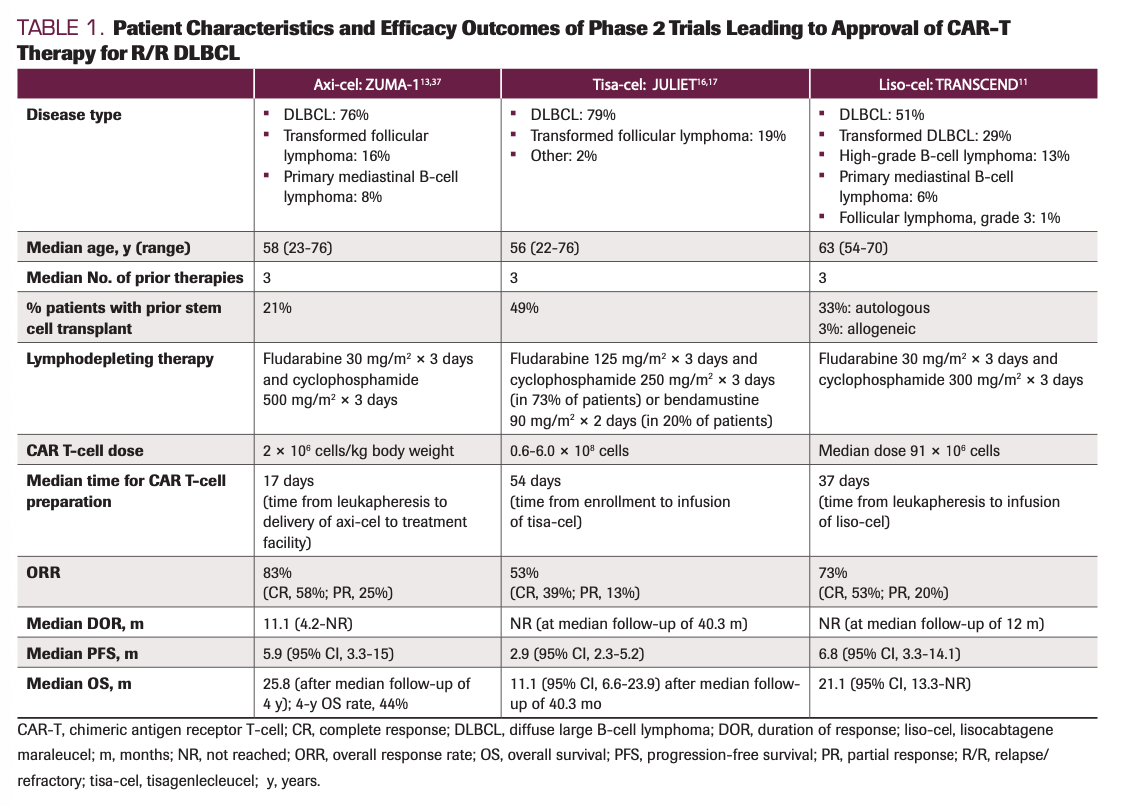
TABLE 2. Safety Data of Phase 2 Trials Leading to Approval of CAR-T Therapy for R/R DLBCL
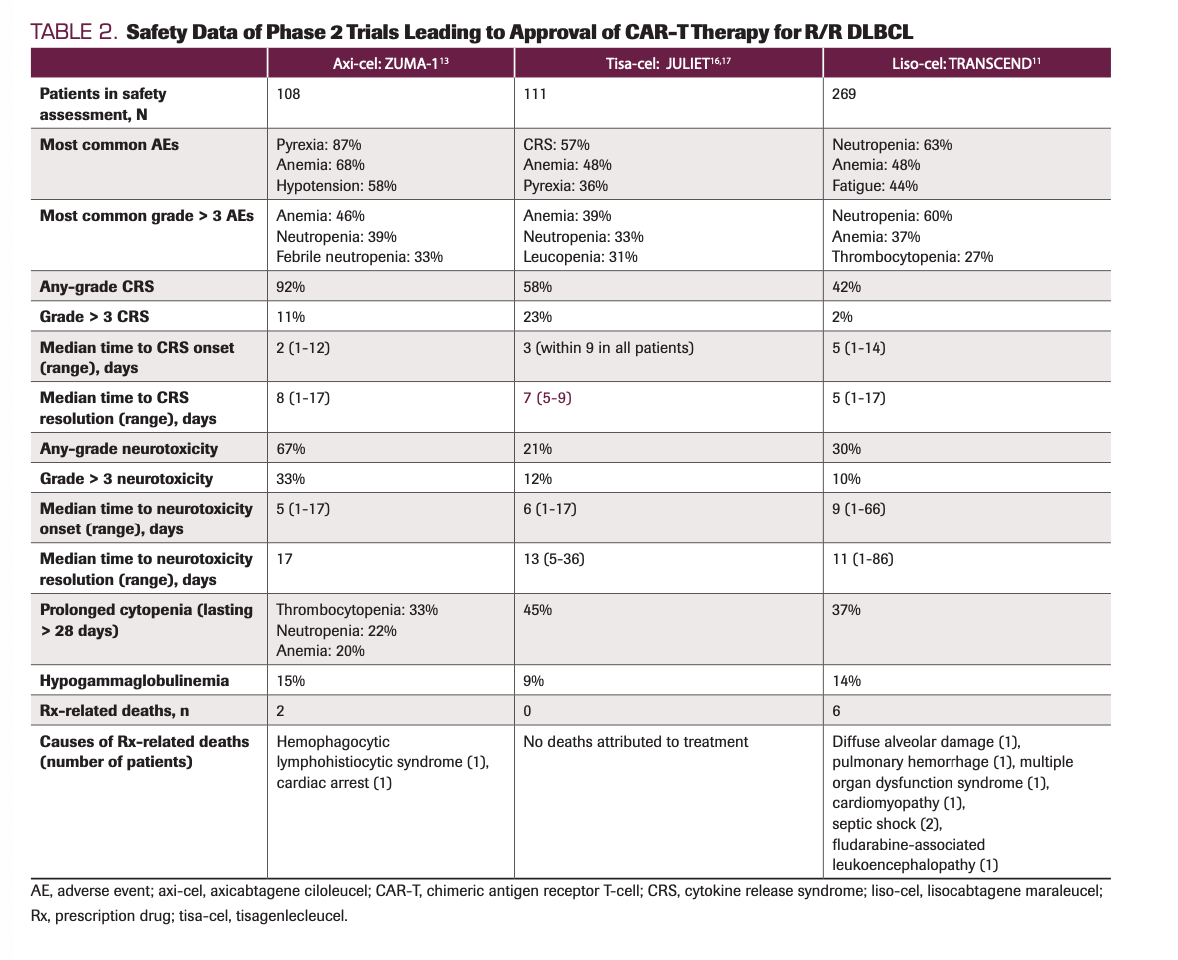
Once approved, real-world use commenced, and initial retrospective experiences were reported. The initial retrospective analysis of real-word usage of standard of care axi-cel for R/R DLBCL included 129 patients treated with axi-cel at 17 US institutions. Approximately 40% of the patients included would not have met the eligibility criteria for the ZUMA-1 study (NCT02348216). Nevertheless, the initial real-world outcomes of this series were comparable with those of ZUMA-1, with an ORR of 82% and a CR rate of 64% at a median follow-up of 12.9 months. The median PFS was 8.3 months (95% CI, 6-15), and median OS was not reached.7
Which CAR-T to Use?
Overall, around 50% of patients treated with CAR-T therapy achieve a CR. The durability of remission also appears similar across the 3 CAR-T products, with the longest-term follow-up approaching 5 years. Prior reports demonstrate a stable tail to the PFS/OS curve.
The immediate toxicity of CAR-T therapy is well documented; it includes the incidence and all-grade severity of cytokine release syndrome (CRS) and neurotoxicity (or immune effector cell–associated neurotoxicity syndrome [ICANS]). In a nonrandomized comparison, CRS and neurotoxicity appear higher with axi-cel (92% and 67%, respectively) compared with tisa-cel (58% and 21%) and liso-cel (42% and 30%). This variation is likely due to several factors, including differences in the T-cell expansion kinetics, the different costimulation domains, and CRS/ICANS treatment strategies. The relatively higher incidence of grade 3 or higher CRS with tisa-cel (JULIET trial [NCT02445248]) could be due to the Penn grading8 system, which results in higher rates relative to those calculated with the Lee criteria,9 which were used in TRANSCEND (NCT02631044; liso-cel) and ZUMA-1 (axi-cel). Hence, the use of liso-cel or tisa-cel may be more appealing for patients who have increased risk for . CRS or limited reserve to tolerate the toxicity of CRS; careful outpatient administration in selected patients could also be considered.10
More patients are likely to be eligible to receive CAR-T products than HDT-ASCR. There is no upper age limit set for any CAR-T construct. Many patients with moderate comorbidities who may be at high risk for HDT-ASCR’s toxicities or who are ineligible for HDT-ASCR may safely receive CAR-T therapy. The TRANSCEND study included patients with moderate comorbidities of renal dysfunction (creatinine clearance,>30 to<60 mL/min), cardiac dysfunction (left ventricular ejection fraction, ≥40% to <50%), low absolute lymphocyte count (no minimum count required), and secondary central nervous system involvement. Patients older than 65 years and patients with moderate comorbidities achieved response rates and safety outcomes comparable with those of patients younger than 65 years and those with no comorbidities; the ORR was 75.9% for those older than 65 years vs 70.3% in those younger than 65 years.11
“Dazed” During the Brain-to-Vein Yet Confident in the Vein-to-Vein
The Achilles heel of CAR-T therapy is time: This includes not only the complex manufacturing process that results in a prolonged time from leukapheresis to the infusion of CAR-Ts (vein-to-vein) but the time it takes from the decision to proceed to CAR-T to actual apheresis (brain-to-vein). Although the vein-to-vein time is reliably measurable, both in and outside clinical trials, the brain-to-vein time is subject to institutional interpretation and less likely to be universally reported. The fastest vein-to-vein time was with axi-cel at 17 days in the ZUMA-1 trial, and this appears to be consistent with the real-world experience. The vein-to-vein time was a median of 37 days with liso-cel in the TRANSCEND trial, but it appears to be shorter in the commercial environment. The longest vein-to-vein time was with tisa-cel at a median of 54 days. However, these data were affected by the fact that in manufacturing tisa-cel, the postapheresis product is frozen and used when needed or when the CAR-T manufacturing slots are available; this is unlike the manufacturing processes of axi-cel and liso-cel, which utilize fresh, not frozen, apheresis products.12
In the commercial environment, brain-to-vein time is crucial because many patients have rapidly evolving disease. If we could account for this period, the efficacy outcomes of CAR-T therapy are likely to be inferior, but data to substantiate this are lacking. Also lacking are essential data on the best intensive salvage strategies in the setting of multiply refractory disease; these intensive salvage strategies may cause significant toxicity and decline in ECOG performance score without disease control.
Classically, bridging therapy has been defined in studies as treatment administered within the vein-to-vein time. In the ZUMA-1 trial, bridging therapy was not allowed during this time.13 However, in the real-world axi-cel series of 276 patients,14 53% of patients received bridging therapy with a full spectrum of therapies, including steroid monotherapy in 24%, chemotherapy in 50%, localized radiation in 16%, and targeted therapies in 10%. Compared with patients in the non–bridging therapy cohort, patients in the bridging therapy cohort had poor OS (P=.001) and poor lymphoma-specific survival (P=.019), and they were more likely to have an ECOG score of 2 or more (24.8% vs 6.1%), IPI score of 3 or greater (67.6% vs 34.3%), and double- or triple-hit lymphoma (42.5% vs 24.6%). The results of another retrospective axi-cel analysis were similar15: It included 148 patients, of whom 55% received bridging therapy. Compared with those who did not receive bridging therapy, those who did had worse 1-year PFS (21% vs 40%) and worse 1-year OS (48% vs 65%); however, patients bridged with radiation had better PFS compared with those bridged with systemic therapy (P<.01).15 All patients bridged with radiation received CAR-T therapy compared with only 74% of patients bridged with systemic therapy. There were no deaths in those bridged with radiation compared with 7 deaths in those bridged with systemic therapy. It is possible this could be due to more limited disease in patients selected for radiation bridging. This retrospective analysis suggests the potential role of bridging radiation therapy, but prospective studies are needed to confirm these findings and potentially determine the optimal timing, field, and dose of radiation.
In the JULIET trial,16,17 bridging therapy was allowed. Given the unique manufacturing process within JULIET, 92% of patients received bridging therapy, with combinations of rituximab (54%), gemcitabine (40%), etoposide (26%), dexamethasone (25%), cisplatin (19%), cytarabine (19%), ibrutinib (Imbruvica; 9%) and lenalidomide (Revlimid; 7%). The outcomes were poor in those with bridging therapy vs no bridging, and the 12-month PFS rates were 32% and 61%, respectively.
In the TRANSCEND trial,11 bridging therapy was also allowed, but reconfirmation of PET-positive disease before lymphodepleting chemotherapy was required. Of the 59% of patients who received bridging therapy, 88% received systemic therapy alone, 4% radiotherapy alone, and 8% received both. The most used systemic therapy was rituximab with or without gemcitabine-oxaliplatin (19%). Bridging therapy did not result in a lower tumor burden in most patients. Compared with those who did not receive bridging therapy, those who did had poorer outcomes: ORR, 67.3% vs 80.2%; median PFS, 5 months vs 14.1 months; median OS, 12.7 months vs not reached. Patients who received bridging therapy also had higher incidence of grade 3 or higher adverse events (AEs; 86% vs 69%), CRS (51% vs 3%), grade 3 or higher CRS (3% vs 0.9%), neurological events (33% vs 24.5%), and grade 3 or higher neurotoxicity (13% vs 5.5%).
Across all CAR-T trials, those who received bridging therapy had worse outcomes and increased toxicity. Having some decrease in lymphoma tumor burden after bridging therapy is associated with results that are slightly better than in those with no response or progressive disease after bridging therapy. Poor outcomes in these patients could be due to aggressive disease with higher tumor burden rather than bridging therapy itself; alternatively, bridging therapy might alter the host or tumor microenvironment, such that CAR-T efficacy is affected.
“Confused” About When to Use CAR T-Cell Therapy
Given the durable responses to CAR-T therapy, the obvious question is whether moving CAR-T therapy up in the treatment algorithm to the second line could lead to better efficacy outcomes than the current standard of care (SOC) of salvage chemotherapy followed by HDT-ASCR. Three phase 3 trials—ZUMA-7 (NCT03391466; axi-cel),18 BELINDA (NCT03570892; tisa-cel),19 and TRANSFORM (NCT03575351; liso-cel)20—randomized patients, all refractory or relapsed within 12 months of first-line treatment with a CD20 antibody and an anthracycline-containing regimen, to either CAR-T therapy or SOC (salvage chemotherapy followed by HDT-ASCR; Table 3).
TABLE 3. Patient Characteristics, Efficacy Outcomes, and Safety Data of Phase 3 Trials Evaluating CAR-T Therapy in the Second-Line Setting for High-Risk R/R DLBCL (Primary Refractory and Relapsed Within 12 Months)
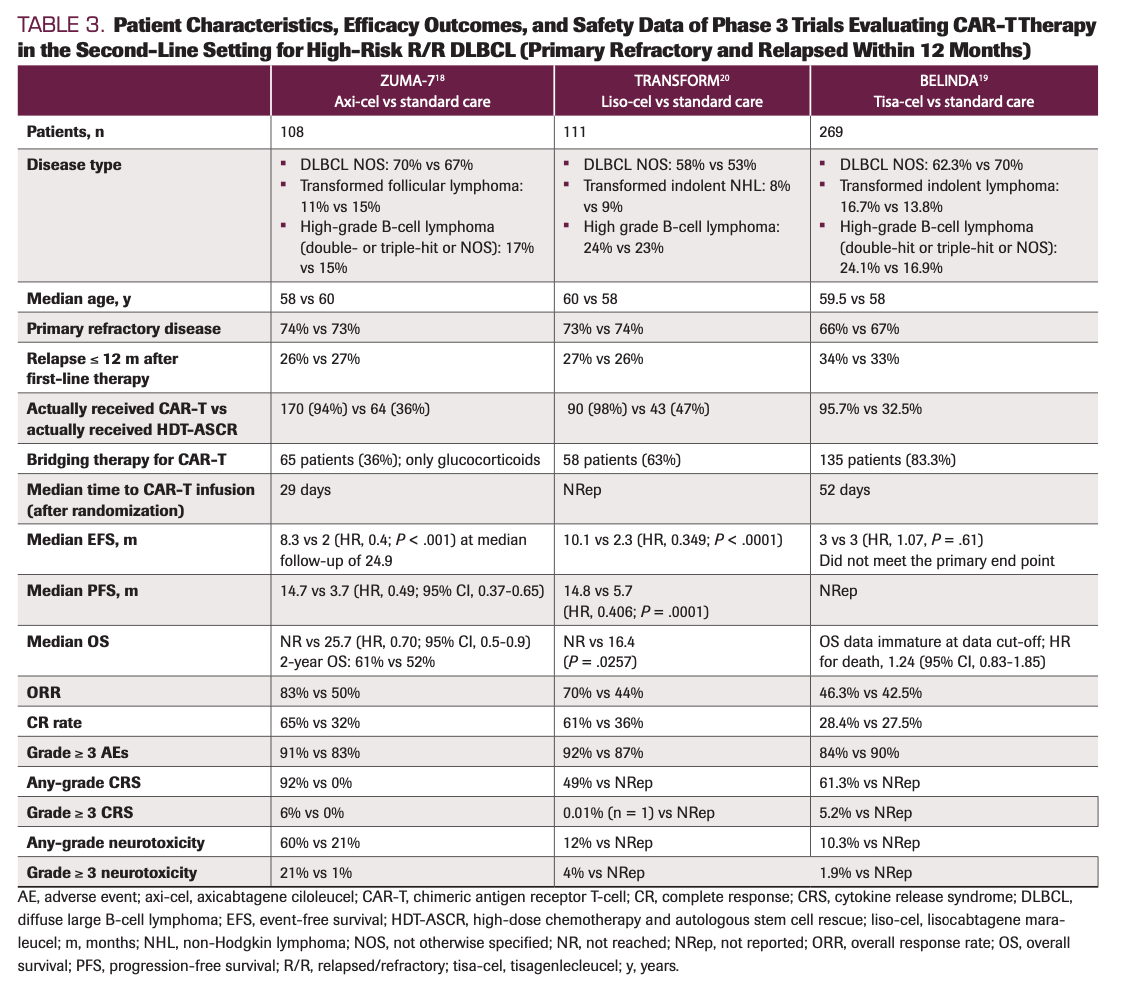
ZUMA-7 and TRANSFORM both met their primary end point of improved event-free survival; although the OS benefits (at the interim analyses) remain immature, there was a trend toward improved OS in both. However, BELINDA was a negative trial, and it is unclear if this discordant result was due to differences in baseline patient characteristics (ie, higher-risk patients), differences in bridging therapy (i.e., highest use of bridging therapy was in BELINDA with 83% of patients received bridging therapy), or longer vein-to-vein time for CAR-T infusion. Currently, FDA approval for the use of axi-cel or liso-cel in the second-line setting for this patient population (R/R at >12 months) is pending but expected soon. Studies would be necessary to compare CAR-T therapy with HDT-ASCR in patients who relapse after 12 months from first-line treatment.
“Confused” When to Use Emerging Therapies
Like CAR-T therapies, several non–CAR-T therapies have been approved for use in R/R DLBCL based on single-arm trials and small phase 2 randomized trials. It is important to note that both tafasitamab (Monjuvi) and loncastuximab tesirine (Zynlonta) engage CD19, the same tumor-associated antigen targeted by CAR-T therapies. How the efficacy of CAR-T therapy may be altered by perturbation of CD19 prior to CAR-T is unlikely to be studied prospectively, and limited retrospective data are likely to emerge. Furthermore, as noted above, these targeted agents were not used as a bridging therapy in the clinical trials leading to CAR-T therapy approval. Currently, we have limited data in the brain-to-vein or vein-to-vein time. In vitro testing has shown that targeting CD19 with the monoclonal antibody tafasitamab did not impair CD19 CAR-T activity.21 Nevertheless, the targeted therapies discussed below, with an expanded list of attributes in Table 4, provide a confusing sequence of treating R/R DLBCL. It is logistically easier to administer targeted therapies than CAR-T therapy, because the former are available to be used “off the shelf” compared with the time-consuming, complex manufacturing process involved with CAR-T.
TABLE 4. Patient Characteristics and Efficacy Outcomes of Targeted Therapies
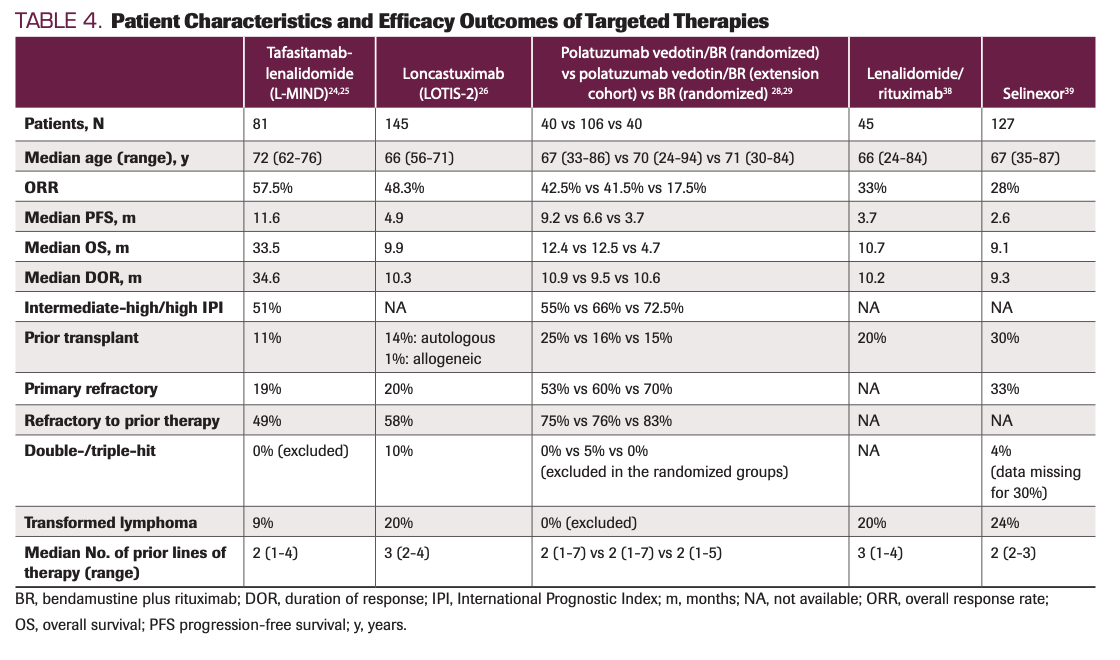
Tafasitamab promotes cell death through enhanced antibody-dependent cellular cytotoxicity and phagocytosis. As a single agent, tafasitamab demonstrated clinical activity in patients with R/R DLBCL in a phase 2a study,22 with an ORR of 26% and CR rate of 6% in a limited population. Combinatorial studies demonstrated in vitro synergy with lenalidomide, leading to the combination of tafasitamab and lenalidomide (tafa-len).23 The L-MIND study (NCT02399085)24 was a phase 2, single-arm trial in patients with R/R DLBCL who were ineligible for HDT-ASCR. Participants received tafasitamab at 12 mg/kg intravenously (IV) on days 1, 4 (first cycle only), 8, 15, and 22 of each 28-day cycle for 3 cycles, and then on days 1 and 15 of each subsequent 28-day cycle. The lenalidomide was dosed at 20 mg daily on days 1 to 21 of each cycle for a maximum of 12 cycles. After 12 cycles, tafasitamab was continued every 2 weeks to those achieving clinical benefit. This study excluded participants with any of the following: double-hit or triple-hit lymphoma, previous treatment with anti-CD19 therapy, prior exposure to lenalidomide analogues, or creatinine clearance less than 60 mL/min. With a long-term follow-up of 24 months or more after the last patient enrolled, the ORR was 57.5%, with 40% achieving a CR. The median time to initial response was 2 months, and the median duration of response (DOR) was 34.6 months. The median OS was 33.5 months at a median follow-up of 42.7 months. The most common grade 3 or higher AEs were neutropenia (48%) and thrombocytopenia (17%); the latter appeared to diminish after completion of the lenalidomide.24,25
Loncastuximab tesirine is a CD19-directed antibody-drug conjugate (ADC) with a pyrrolobenzodiazepine dimer payload that leads to interstrand DNA cross-links and cell death after being internalized. FDA approval of loncastuximab tesirine was based on the phase 2, single-arm LOTIS-2 trial (NCT03589469), which evaluated its efficacy in 145 patients with R/R DLBCL who had received at least 2 prior systemic therapies. Participants had to have proven CD19 expression if a prior CD19-directed therapy was used, including CAR-T. The trial excluded patients with bulky disease (>10 cm in longest dimension). Loncastuximab tesirine was given at a dose of 150 µg/kg every 21 days for 2 cycles, followed by 75 µg/kg every 21 days for up to 1 year; maintenance consisted of 75 µg/kg every 3 months for up to 3 years. The ORR was 48.3%, with a CR rate of 24%. The median time to response was 41 days; median DOR was 10.3 months. The median DOR was 13.4 months for patients achieving a CR. The median PFS and OS were 4.9 months and 9.9 months, respectively. The most common grade 3 or higher AEs were neutropenia (26%), thrombocytopenia (18%), and elevated γ-glutamyl transferase (17%).26
Given the allowance of prior CD19 agents, loncastuximab tesirine could be used as a potential bridge to CAR-T therapy or consolidative transplant. In the LOTIS-2 trial, 3% of patients had subsequent autologous stem cell transplant, 3% had allogeneic stem cell transplant, and 10% received subsequent CD19-directed CAR-T therapy. Forty-seven percent of the patients who received subsequent CAR-T therapy had a 40% CR rate, and CD19 expression was present in all patients who were biopsied. This could suggest that CD19 antigen loss after loncastuximab tesirine exposure is less common and perhaps not a resistance mechanism to CAR-T therapy. Only 9% of the participants in the LOTIS-2 trial had received prior CAR-T therapy, and their ORR was 46.2%, which was comparable with the ORR of 48% in the group who did not receive prior CD19-directed CAR-T therapy. Thus, loncastuximab tesirine could be used before and after CAR-T therapy and likely should not hinder moving toward CAR-T therapy.
Polatuzumab vedotin is a CD79b-directed ADC with a monomethyl auristatin E payload. The efficacy of polatuzumab/rituximab was studied in the phase 2 ROMULUS study (NCT01691898)27 in R/R NHL. Thirty-nine participants received polatuzumab dosed at 2.4 mg/kg plus rituximab 375 mg/m2 every 21 days. The ORR was 56% with 15 CRs; the median PFS was 5.4 months. The most frequent AEs were neutropenia, peripheral neuropathy, and diarrhea.
Polatuzumab was subsequently combined with the commonly used combination of bendamustine and rituximab (BR) in a small, randomized phase 2 trial that compared polatuzumab/BR with BR alone in transplant-ineligible R/R DLBCL.28,29 Forty patients received bendamustine at 90 mg/m2 IV on days 1 and 2 plus rituximab at 375 mg/m2 IV on day 1 of every 21-day cycle for up to 6 cycles, although another 40 patients received polatuzumab at 1.8 mg/kg IV on day 1 of every 21-day cycle in addition to BR on the same schedule as the other cohort. The polatuzumab/BR arm had a higher ORR (42.5% vs 17.5%, respectively), higher CR rate (40% vs 17.5%; P = .026), longer median PFS (9.2 vs 3.7 months; HR, 0.39; 95% CI, 0.23-0.66), and longer median OS (12.4 vs 4.7 months; HR, 0.42; 95% CI, 0.24-0.72). The benefit was seen regardless of the number of prior lines of therapy, age, IPI score, presence of bulky disease, and reported cell of origin. Polatuzumab/BR had increased toxicity compared with BR alone with higher rates of grade 3/4 neutropenia (46.2% vs 33.3%), grade 3/4 anemia (28.2% vs 17.9%), grade 3/4 thrombocytopenia (41% vs 23.1%), and rates of peripheral neuropathy (43.6% vs 7.7%). There were similar rates of grade 3/4 infections (23.1% vs 20.5%). Of note, all neuropathies in both groups were grade 1/2, with resolution or improvement in all cases after discontinuation. After positive results with polatuzumab/BR in the randomized phase, an additional 106 patients received polatuzumab/BR in a single-arm extension cohort. Overall efficacy in this polatuzumab/BR extension cohort is similar to that of the polatuzumab/BR randomized cohort, with no new safety signals or concerns (results summarized in Table 4).29
Given the high ORR and non-CD19 perturbation, there has been significant interest in the use of polatuzumab-based regimens as a bridge to CAR-T therapy. A recent retrospective analysis assessed the efficacy of polatuzumab-based regimens as a bridge to CAR-T therapy in 41 patients (patients received either polatuzumab/BR, polatuzumab/rituximab, polatuzumab monotherapy, or polatuzumab/rituximab/cyclophosphamide/doxorubicin). Twenty-eight of 41 (68%) patients successfully received CAR T-therapy; the 12-month OS in those who received CAR-T therapy was 58.5%, calculated from the time of polatuzumab initiation. Regarding the adequacy of apheresis, among the 10 patients treated with polatuzumab/BR who underwent apheresis, 1 patient required a second leukapheresis and 1 patient had failed repeated leukapheresis.30 The lymphotoxic effects of bendamustine had led to the concern of inadequate or limited ability to manufacture CAR-T products if bendamustine is used prior to apheresis. Hence, polatuzumab monotherapy or a polatuzumab/rituximab combination could be used for bridging during the brain-to-vein period in relatively stable patients who need bridging and, if needed, polatuzumab/BR could be used for bridging after apheresis.
Authors’ Opinion on the Future Direction of the R/R DLBCL Landscape
The R/R DLBCL therapeutics landscape is changing rapidly. The first CAR-T therapy, axi-cel, was approved in 2017 for R/R DLBCL in the third-line setting. It is expected that CAR T-cell therapy will be approved in the second-line setting for high-risk R/R DLBCL (ie, R/R <12 months). The clinical trials involving bispecific T-cell engager (BiTE) antibodies, with promising activity in phase 1/2 trials in heavily pretreated patients, is exciting; CRs have been seen in patients, including those who received prior CAR-T therapy. BiTE antibodies are innovative immunotherapy drugs that activate the immune T-cell activity by binding the antigen on the tumor cells and the antigen on the T cells. Currently, 5 CD20 (tumor cell antigen)/CD3 (T-cell antigen) BiTE antibodies are being studied in phase 1 and 2 trials in patients with R/R NHL, including R/R DLBCL (Table 5).31-35 BiTE antibodies are likely to be approved, expanding the armamentarium of treatment options for R/R DLBCL.
TABLE 5. Patient Characteristics, Efficacy Outcomes, and Safety Data of BiTE Antibodies
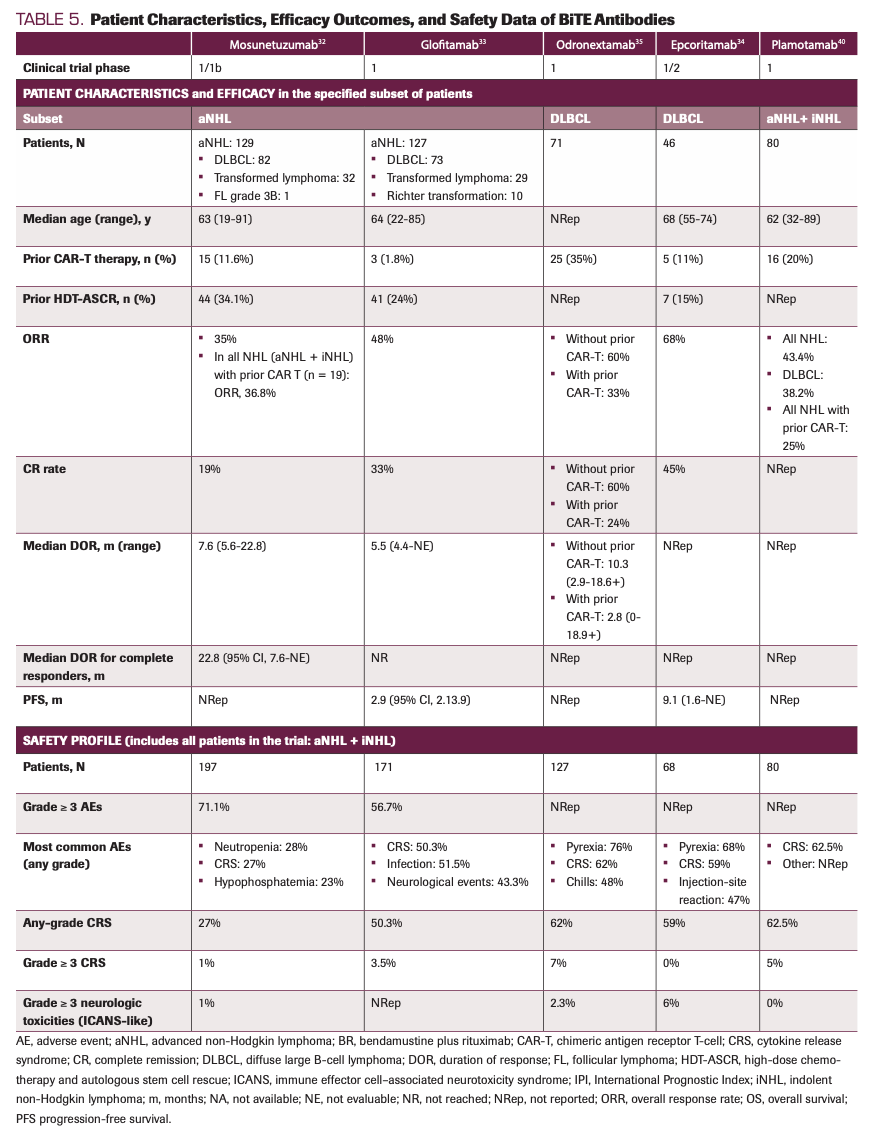
All the targeted agents are currently being used in later lines of therapy, but in several ongoing and planned trials these agents are moved up earlier in the disease course, including to the newly diagnosed setting. The recent POLARIX trial (NCT03274492)36 showed improved PFS with polatuzumab/R-CHP (rituximab, cyclophosphamide, doxorubicin, and prednisone) compared with the current SOC R-CHOP (rituximab, cyclophosphamide, doxorubicin, vincristine, and prednisone) in patients with newly diagnosed high-risk IPI DLBCL; the PFS was 76.7% vs 70.2%, respectively, after a median follow-up of 28.2 months (HR, 0.73; 95% CI, 0.57-0.95), with a similar safety profile in both arms. This was the first positive trial in the first-line DLBCL setting in almost 20 years. Once polatuzumab/R-CHP is approved and patients are treated with this regimen in the first-line setting, physicians will be hesitant about reusing polatuzumab once the patient relapses, especially with several alternative treatment options available.
Undoubtedly, the treatment strategies of both newly diagnosed DLBCL and R/R DLBCL will look quite different in the next few years. With multiple treatment options available—which could be used in different lines of treatment—among the biggest challenges are knowing the best sequencing of these agents, and if (and when) patients could be rechallenged with the same treatment if needed. Long-term clinical trial data together with real-world outcomes will help inform treatment decisions.
Disclosure: MK has no conflicts or disclosures. MAL receives consultancy fees from AbbVie, Acrotech, ADC Therapeutics, Astellas, AstraZeneca, Bristol Myers Squibb, Daiichi Sankyo, EUSA Pharma, Fate Therapeutics, Genentech, Kite, Instil Bio, MorphoSys, Nurix, Sana Pharma, TG Therapeutics.
Author affiliations:
Meghana Kesireddy, MBBS1; Matthew A. Lunning, MD1
1Department of Hematology and Oncology, University of Nebraska Medical Center, Omaha, Nebraska.
REFERENCES
- Larouche J-F, Berger F, Chassagne-Clément C, et al. Lymphoma recurrence 5 years or later following diffuse large B-cell lymphoma: clinical characteristics and outcome. J Clin Oncol. 2010;28(12):2094-2100. doi:10.1200/JCO.2009.24.5860
- El-Galaly TC, Jakobsen LH, Hutchings M, et al. Routine imaging for diffuse large B-cell lymphoma in first complete remission does not improve post-treatment survival: a Danish-Swedish population-based study. J Clin Oncol. 2015;33(34):3993-3998. doi:10.1200/JCO.2015.62.0229
- Hamlin PA, Zelenetz AD, Kewalramani T, et al. Age-adjusted International Prognostic Index predicts autologous stem cell transplantation outcome for patients with relapsed or primary refractory diffuse large B-cell lymphoma. Blood. 2003;102(6):1989-1996. doi:10.1182/blood-2002-12-3837
- Perales M-A, Jenq R, Goldberg JD, et al. Second-line age-adjusted International Prognostic Index in patients with advanced non-Hodgkin lymphoma after T-cell depleted allogeneic hematopoietic SCT. Bone Marrow Transplant. 2010;45(9):1408-1416. doi:10.1038/bmt.2009.371
- Crump M, Neelapu SS, Farooq U, et al. Outcomes in refractory diffuse large B-cell lymphoma: results from the international SCHOLAR-1 study. Blood. 2017;130(16):1800-1808. doi:10.1182/blood-2017-03-769620. Published correction appears in Blood. 2018;131(5):587-588.
- van Imhoff GW, McMillan A, Matasar MJ, et al. Ofatumumab versus rituximab salvage chemoimmunotherapy in relapsed or refractory diffuse large B-cell lymphoma: the ORCHARRD study. J Clin Oncol. 2017;35(5):544-551. doi:10.1200/JCO.2016.69.0198
- Nastoupil LJ, Jain MD, Feng L, et al. Standard-of-care axicabtagene ciloleucel for relapsed or refractory large B-cell lymphoma: results from the US Lymphoma CAR T Consortium. J Clin Oncol. 2020;38(27):3119-3128. doi:10.1200/JCO.19.02104
- Schuster SJ, Maziarz RT, Rusch ES, et al. Grading and management of cytokine release syndrome in patients treated with tisagenlecleucel in the JULIET trial. Blood Adv. 2020;4(7):1432-1439. doi:10.1182/bloodadvances.2019001304
- Lee DW, Gardner R, Porter DL, et al. Current concepts in the diagnosis and management of cytokine release syndrome. Blood. 2014;124(2):188-195. doi:10.1182/blood-2014-05-552729. Published correction appears in Blood. 2016; 128(11):1533.
- Bachier CR, Godwin JE, Andreadis C, et al. Outpatient treatment with lisocabtagene maraleucel (liso-cel) across a variety of clinical sites from three ongoing clinical studies in relapsed/refractory (R/R) large B-cell lymphoma (LBCL). J Clin Oncol. 2020.38(15 suppl):8037. doi:10.1200/JCO.2020.38.15_suppl.8037
- Abramson JS, Palomba ML, Gordon LI, et al. Lisocabtagene maraleucel for patients with relapsed or refractory large B-cell lymphomas (TRANSCEND NHL 001): a multicentre seamless design study. Lancet. 2020;396(10254):839-852. doi:10.1016/S0140-6736(20)31366-0
- Westin JR, Kersten MJ, Salles G, et al. Efficacy and safety of CD19-directed CAR-T cell therapies in patients with relapsed/refractory aggressive B-cell lymphomas: observations from the JULIET, ZUMA-1, and TRANSCEND trials. Am J Hematol. 2021;96(10):1295-1312. doi:10.1002/ajh.26301
- Neelapu SS, Locke FL, Bartlett NL, et al. Axicabtagene ciloleucel CAR T-cell therapy in refractory large B-cell lymphoma. N Engl J Med. 2017;377(26):2531-2544. doi:10.1056/NEJMoa1707447
- Jain MD, Jacobs MT, Nastoupil LJ, et al. Characteristics and outcomes of patients receiving bridging therapy while awaiting manufacture of standard of care axicabtagene ciloleucel CD19 chimeric antigen receptor (CAR) T-cell therapy for relapsed/refractory large B-cell lymphoma: results from the US Lymphoma CAR-T Consortium. Blood. 2019;134(suppl 1):245. doi.10.1182/blood-2019-129624
- Pinnix CC, Gunther JR, Dabaja BS, et al. Bridging therapy prior to axicabtagene ciloleucel for relapsed/refractory large B-cell lymphoma. Blood Adv. 2020;4(13):2871-2883. doi:10.1182/bloodadvances.2020001837
- Schuster SJ, Bishop MR, Tam CS, et al; JULIET Investigators. Tisagenlecleucel in adult relapsed or refractory diffuse large B-cell lymphoma. N Engl J Med. 2019;380(1):45-56. doi:10.1056/NEJMoa1804980
- Schuster SJ, Tam CS, Borchmann P, et al. Long-term clinical outcomes of tisagenlecleucel in patients with relapsed or refractory aggressive B-cell lymphomas (JULIET): a multicentre, open-label, single-arm, phase 2 study. Lancet Oncol. 2021;22(10):1403-1415. doi:10.1016/S1470-2045(21)00375-2
- Locke FL, Miklos DB, Jacobson CA, et al; All ZUMA-7 Investigators and Contributing Kite Members. Axicabtagene ciloleucel as second-line therapy for large B-cell lymphoma. N Engl J Med. 2022;386(7):640-654. doi:10.1056/NEJMoa2116133
- Bishop MR, Dickinson M, Purtill D, et al. Second-line tisagenlecleucel or standard care in aggressive B-cell lymphoma. N Engl J Med. 2022;386(7):629-639. doi:10.1056/NEJMoa2116596
- Kamdar M, Solomon SR, Arnason JE. Lisocabtagene maraleucel (liso-cel), a CD19-directed chimeric antigen receptor (CAR) T cell therapy, versus standard of care (SOC) with salvage chemotherapy (CT) followed by autologous stem cell transplantation (ASCT) as second-line (2L) treatment in patients (pts) with relapsed or refractory (R/R) large B-cell lymphoma (LBCL): results from the randomized phase 3 TRANSFORM study. Blood. 2021;138(Suppl_1):91. doi.10.1182/blood-2021-147913
- Horvei P, Sakemura R, Cox MJ, et al. Targeting of CD19 by tafasitamab does not impair CD19 directed chimeric antigen receptor T cell activity in vitro. Blood. 2019;134(Suppl 1):2859. doi:10.1182/blood-2019-130506
- Jurczak W, Zinzani PL, Gaidano G, et al. Phase IIa study of the CD19 antibody MOR208 in patients with relapsed or refractory B-cell non-Hodgkin’s lymphoma. Ann Oncol. 2018;29(5):1266-1272. doi:10.1093/annonc/mdy056
- Lagrue K, Carisey A, Morgan DJ, Chopra R, Davis DM. Lenalidomide augments actin remodeling and lowers NK-cell activation thresholds. Blood. 2015;126(1):50-60. doi:10.1182/blood-2015-01-625004
- Salles G, Duell J, González Barca E, et al. Tafasitamab plus lenalidomide in relapsed or refractory diffuse large B-cell lymphoma (L-MIND): a multicentre, prospective, single-arm, phase 2 study. Lancet Oncol. 2020;21(7):978-988. doi:10.1016/S1470-2045(20)30225-4
- Duell J, Maddocks KJ, González-Barca E, et al. Long-term analyses from the phase II L-MIND study of tafasitamab (MOR208) plus lenalidomide in patients with relapsed or refractory diffuse large B-cell lymphoma. Haematologica. 2021;106(9):2417-2426. doi:10.3324/haematol.2020.275958
- Caimi PF, Ai W, Alderuccio JP, et al. Loncastuximab tesirine in relapsed or refractory diffuse large B-cell lymphoma (LOTIS-2): a multicentre, open-label, single-arm, phase 2 trial. Lancet Oncol. 2021;22(6):790-800. doi:10.1016/S1470-2045(21)00139-X
- Morschhauser F, Flinn IW, Advani R, et al. Polatuzumab vedotin or pinatuzumab vedotin plus rituximab in patients with relapsed or refractory non-Hodgkin lymphoma: final results from a phase 2 randomised study (ROMULUS). Lancet Haematol. 2019;6(5):e254-e265. doi:10.1016/S2352-3026(19)30026-2
- Sehn LH, Herrera AF, Flowers CR, et al. Polatuzumab vedotin in relapsed or refractory diffuse large B-cell lymphoma. J Clin Oncol. 2020;38(2):155-165. doi:10.1200/JCO.19.00172
- Sehn LH, Hertzberg M, Opat S, et al. Polatuzumab vedotin plus bendamustine and rituximab in relapsed/refractory DLBCL: survival update and new extension cohort data. Blood Adv. 2022;6(2):533-543. doi:10.1182/bloodadvances.2021005794
- Liebers N, Duell J, Fitzgerald D, et al. Polatuzumab vedotin as a salvage and bridging treatment in relapsed or refractory large B-cell lymphomas. Blood Adv. 2021;5(13):2707-2716. doi:10.1182/bloodadvances.2020004155
- Tilly H, Morschhauser F, Sehn LH, et al. Polatuzumab vedotin in previously untreated diffuse large B-cell lymphoma. N Engl J Med. 2022;386(4):351-363. doi:10.1056/NEJMoa2115304
- Davies J, Patel M, Gridelli C, de Marinis F, Waterkamp D, McCusker ME. Real-world treatment patterns for patients receiving second-line and third-line treatment for advanced non-small cell lung cancer: a systematic review of recently published studies. PLoS One. 2017;12(4):e0175679. doi:10.1371/journal.pone.0175679
- Budde LE, Assouline S, Sehn LH, et al. Single-agent mosunetuzumab shows durable complete responses in patients with relapsed or refractory B-cell lymphomas: phase I dose-escalation study. J Clin Oncol. 2022;40(5):481-491. doi:10.1200/JCO.21.00931
- Hutchings M, Morschhauser F, Iacoboni G, et al. Glofitamab, a novel, bivalent CD20-targeting T-cell-engaging bispecific antibody, induces durable complete remissions in relapsed or refractory B-cell lymphoma: a phase I trial. J Clin Oncol. 2021;39(18):1959-1970. doi:10.1200/JCO.20.03175
- Hutchings M, Mous R, Roost Clausen M, et al. Dose escalation of subcutaneous epcoritamab in patients with relapsed or refractory B-cell non-Hodgkin lymphoma: an open-label, phase 1/2 study. Lancet. 2021;398(10306):1157-1169. doi:10.1016/S0140-6736(21)00889-8
- Bannerji RM, Allan JN, Arnason JE, et al. Odronextamab (REGN1979), a human CD20 x CD3 bispecific antibody, induces durable, complete responses in patients with highly refractory B-cell non-Hodgkin lymphoma, including patients refractory to CAR T therapy. Blood. 2020;136(Suppl_1):42. doi.10.1182/blood-2020-136659
- Jacobson C, Locke FL, Ghobadi A, et al. Long-term survival and gradual recovery of B cells in patients with refractory large B cell lymphoma treated with axicabtagene ciloleucel (axi-cel). Blood. 2020;136(Suppl_1):40-42. doi.10.1182/blood-2020-134362
- Wang M, Fowler N, Wagner-Bartak N, et al. Oral lenalidomide with rituximab in relapsed or refractory diffuse large cell, follicular and transformed lymphoma: a phase II clinical trial. Leukemia. 2013;27(9):1902-1909. doi:10.1038/leu.2013.95
- Kalakonda N, Maerevoet M, Cavallo F, et al. Selinexor in patients with relapsed or refractory diffuse large B-cell lymphoma (SADAL): a single-arm, multinational, multicentre, open-label, phase 2 trial. Lancet Haematol. 2020;7(7):e511-e522. doi:10.1016/S2352-3026(20)30120-4
- Patel K, Michot J-M, Chanan-Khan A, et al. Safety and Anti-tumor activity of plamotamab (XmAb13676), an anti-CD20 x anti-CD3 bispecific antibody, in subjects with relapsed/refractory non-Hodgkin’s lymphoma. Blood. 2021;138(Suppl_1):2494. doi.10.1182/blood-2021-144350
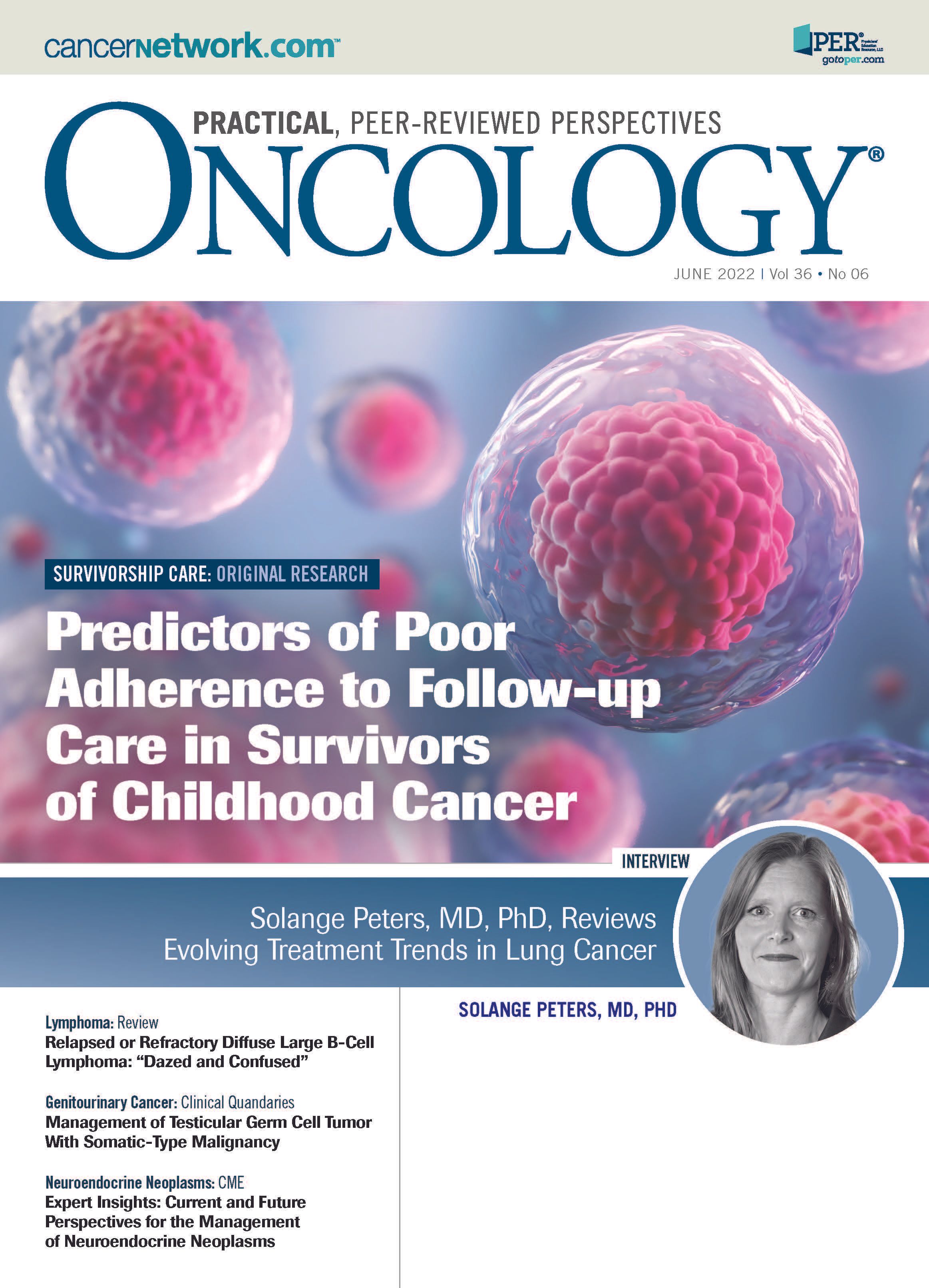
Newsletter
Stay up to date on recent advances in the multidisciplinary approach to cancer.
Highlighting Insights From the Marginal Zone Lymphoma Workshop
Clinicians outline the significance of the MZL Workshop, where a gathering of international experts in the field discussed updates in the disease state.